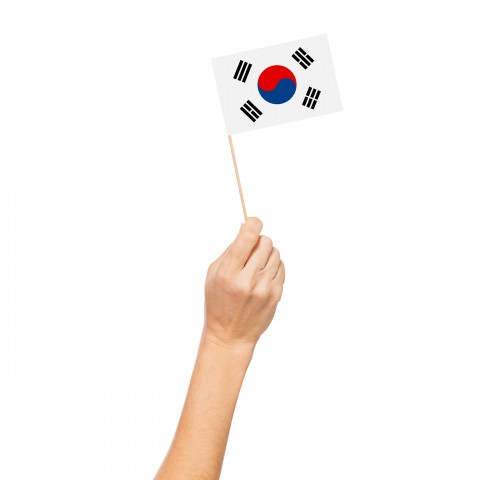“How can I say sorry in Korean?” you may be asking.
“Sorry” is one of the first words that language learners come across when starting out. It’s a practical word because you can use it in many situations. There are many different ways to say sorry in English, such as “I am sorry,” “I apologize,” and so on, and the same is true for Korean. Some Korean apologies are formal and some are slang words, and sometimes words are only used in a specific situation.
“Sorry” in learning Korean is just as essential as it is in any other language. In this blog, we’re going to introduce eleven ways to say “I am sorry” in Korean, and when to use an expression appropriately. There are many words for sorry in Korean vocabulary, as well as many common gestures that make up a big part of how to apologize in Korean culture. Start with a bonus, and download your FREE cheat sheet – How to Improve Your Korean Skills! (Logged-In Member Only)
- 죄송합니다. (joesonghamnida.) – Formal
- 잘못했습니다. (jalmothaetseumnida.) – Formal
- 미안해요. (mianhaeyo.) – Formal
- 죄송해요. (joesonghaeyo.) – Formal.
- 미안해 (mianhae) – Informal
- 미안 (mian) – Informal
- 잠시만요. (jamsimanyo.) – Informal/Formal
- 실례합니다. (sillyehamnida.) – Formal
- 진심으로 사과드립니다. (jinsimeuro sagwadeurimnida.) – Formal
- 용서해주세요. (yongseohaejuseyo.) – Formal
- 저기요 (jeogiyo) – Informal
- How KoreanClass101.com Can Help You
1. 죄송합니다. (joesonghamnida.) – Formal
죄송합니다. (joesonghamnida.) is the most commonly used phrase to say sorry, and if you’ve just started learning how to say sorry in Korean, memorize this phrase at all costs. Why? Because you’ll hear this wherever you go, and you’ll be using it a lot while traveling in South Korea.
죄송합니다. (joesonghamnida.) is a more respectful way to apologize than 미안합니다. (mianhamnida.) and 죄송해요. (joesonghaeyo.), which we’ll explain to you in more detail later.
In addition, using the appropriate body gesture is very important when you say this phrase; you need to slightly bow your head when saying sorry. Also, unlike in some of the countries where eye-contact is very important, making direct eye-contact is considered rude in Korea. Therefore, when you want to apologize to someone, try not to make eye-contact; instead, look slightly downward, toward the floor.
Situation 1:
Someone comes along and pushes you while you’re holding a cup of coffee, which results in spilling the coffee on someone else.
- You: 어머, 괜찮으세요? 너무 *죄송합니다. [bow]
You: eomeo, gwaenchaneuseyo? neomu joesonghamnida.
You: “Oh no, are you okay? I am so sorry.”
*죄송합니다. (joesonghamnida.) is a good way to apologize to someone. However, when you want to more sincerely apologize to someone, add 너무 (neomu), meaning “very,” before 죄송합니다. (joesonghamnida.).
- Customer: 아, 괜찮습니다.
Customer: a, gwaenchanseumnida.
Customer: “Ah, it’s okay.”
In this situation, you spilled the coffee by accident and are sincerely apologizing someone. In this case, you need to bow as you apologize.
Situation 2:
You accidently stepped on someone’s foot when entering the bus.
- You: 죄송합니다. [no need to bow in this situation]
You: joesonghamnida.
You: “I am sorry.” - Other person: 아니요, 괜찮습니다.
Other person: aniyo, gwaenchanseumnida.
Other person: “It’s okay, never mind.”
In this situation, you don’t have enough time to bow and apologize to someone. So this simple version of how to say “I’m sorry” in Korean to the person whose foot you stepped on is good enough.
2. 잘못했습니다. (jalmothaetseumnida.) – Formal
잘못했습니다. (jalmothaetseumnida.) is translated as “It is my fault,” in Korean, and it’s a formal way to say sorry. It’s used when you know that something you did was completely wrong, and want to ask for their forgiveness. You can add 죄송합니다. (joesonghamnida.) to sound more apologetic.
The classical example of how to use this phrase is when a child asks for his mother’s forgiveness. When a child apologizes, he/she usually rubs their hands together as they apologize. The informal way to say 잘못했습니다. (jalmothaetseumnida.) is 잘못했어 (jalmothaesseo).
Situation 1:
You wronged your friend before, and need to apologize to them.
- You: 네 말이 맞았어, 다 내 잘못이야. 잘못했어.*
You: ne mari majasseo, da nae jalmosiya. jalmothaesseo.
You: “You were right, it’s all my fault. Please forgive me.” - Your friend: 휴… 됐다.
Your friend: hyu… dwaetda.
Your friend: “Sigh..whatever.”
* Be careful with spacing the phrase. Many Korean learners make mistakes here. For example, 잘못했습니다. (jalmothaetseumnida.), meaning “It is my fault, I am sorry,” and 잘 못했습니다. (jal mothaetseumnida) meaning “I did not do well,” have two completely different meanings.
3. 미안해요. (mianhaeyo.) – Formal
Each apology expression has a different level of politeness, and 미안해요. (mianhaeyo.) is the least formal way to say “I am sorry.” It’s not often used, but you will hear this expression a lot in Korean dramas. Just note that 미안해요. (mianhaeyo.) is another option for apologizing.
It sounds a lot more natural to say 죄송합니다. (joesonghamnida.) or 죄송해요. (joesonghaeyo.) instead of 미안해요. (mianhaeyo.) in practice. Also, 미안합니다 (mianhamnida) sounds more polite, but in most situations, you should just stick to 죄송합니다. (joesonghamnida.).
Situation 1:
You’ve received many missed calls from someone who’s a couple of years younger than you, and you want to apologize for not answering their calls.
- You: 전화했었어요?. 못 받아서 미안해요.
You: jeonhwahaesseosseoyo?. mot badaseo mianhaeyo.
You: “Did you call? I am sorry for missing your calls.” - Other person: 괜찮습니다. 전화 주셔서 감사합니다.
Other person: gwaenchanseumnida. jeonhwa jusyeoseo gamsahamnida.
Other person: “It’s okay. Thank you for returning the call.”
Situation 2:
A colleague was calling, but you couldn’t pick up the phone because you were driving. You’re returning the call and want to apologize.
- You: 미안해요, 운전하고 있었어요.
You: mianhaeyo, unjeonhagoisseosseoyo.
You: “I am sorry, I was driving.” - Your colleague: 아 그러셨군요. 괜찮습니다.
Your colleague: a geureosyeotgunyo. gwaenchanseumnida.
Your colleague: “I see. It’s okay.”
4. 죄송해요. (joesonghaeyo.) – Formal.
죄송해요. (joesonghaeyo.) has the same meaning as 죄송합니다. (joesonghamnida.), but sounds less formal. You can’t say this phrase to your professor or someone who’s much older than you. If you want to be on the safe side, stick to 죄송합니다. (joesonghamnida.).
Situation 1:
You’ve already asked a few questions to your colleague about something, but you still want to ask more questions.
- You: 바쁘신데 계속 방해해서 죄송해요.
You: bappeusinde gyesok banghaehaeseo joesonghaeyo.
You: “I am sorry to keep bothering you.” - Your colleague: 아닙니다. 괜찮습니다.
Your colleague: animnida. gwaenchanseumnida.
Your colleague: “No, it’s okay.”
Situation 2:
You interrupted someone and the person seems annoyed by it.
- You: 죄송해요 방해할 생각은 아니였어요.
You: joesonghaeyo banghae hal saenggageun aniyeosseoyo.
You: “Sorry, I didn’t mean to interrupt.” - The other person: 괜찮습니다.
The other person: gwaenchanseumnida.
The other person: “It’s okay.”
5. 미안해 (mianhae) – Informal
미안해 (mianhae) is an informal way to say 잘못했습니다. (jalmothaetseumnida.). 미안해 (mianhae) and 미안 (mian) are used interchangeably, but keep in mind that 미안해 (mianhae) sounds more polite and gives the impression that the speaker cares about the listener’s feelings. On the other hand, 미안 (mian) sounds more like how a child would apologize.
Situation 1:
You want to apologize to your friend.
- You: * 정말 미안해, 용서해주라. 응?
You: jeongmal mianhae, yongseohaejura. eung?
You: “I’m really sorry, can you forgive me. Ey?” - Your friend: 알았어. 이번 한번만 용서해줄께.
Your friend: arasseo. ibeon hanbeonman yongseohaejulkke.
Your friend: “Alright. I will forgive you this time.”
* 정말 (jeongmal) means “really.” Add this word if you want to sincerely apologize to your friend.
Situation 2:
You’re supposed to meet your friend at three o’clock, but you arrived half an hour late.
- You: 많이 늦었지? 정말 미안해!
You: mani neujeotji? jeongmal mianhae!
You: “I’m so sorry for arriving late!” - Your friend: 괜찮아. 나도 방금 도착했어.
Your friend: gwaenchana. nado banggeum dochakaesseo.
Your friend: “It’s fine. I’ve just arrived too.”
6. 미안 (mian) – Informal
미안 (mian) is a casual way to apologize to your friends, and the direct translation is “sorry.” In addition, 미안 (mian) can also mean “no” in some situations. For example, when you’re invited to a party organized by your friend and want to politely decline, you can simply say 미안 (mian).
Situation 1:
You’re thirty minutes late and want to apologize to your friend, and need to know how to say “Sorry I’m late,” in Korean.
- You: 늦어서 미안! (=먄!*)
You: neujeoseo mian!
You: “Sorry I’m late!” - Your friend: 괜찮아.
Your friend: gwaenchana.
Your friend: “It’s okay.”
* 먄 (myan) is a shorter word to say sorry, and it’s a Korean slang. This Korean slang is used frequently in written context among young people. A more polite Korean slang to say sorry is 죄송 (joeson), which is another casual way for people of the same age to apologize to each other.
Situation 2:
You’re invited to a party that you don’t want to go to.
- Your friend: 이번주 토요일에 이태원에서 하는 파티 갈래?
Your friend: ibeonju toyoire itaewoneseo haneun pati gallae?
Your friend: “Do you want to go to a party in Itaewon this Saturday?” - You: 음… 미안. 별로 가고 싶지 않네.
You: eum… mian. byeollo gago sipji anne.
You: “Hmm… sorry. I don’t feel like going.” - Your friend: 알았어.
Your friend: arasseo.
Your friend: “Alright.”
7. 잠시만요. (jamsimanyo.) – Informal/Formal
The direct translation of 잠시만요. (jamsimanyo.) is “please hold on.” It also translates as “Excuse me,” in Korean depending on the situation, and is roughly how to say “Excuse me, sorry” in Korean. 실례합니다. (sillyehamnida.), which we’ll discuss below, and 잠시만요 (jamsimanyo.) are interchangeable; by just remembering one of these two phrases, you’ll be able to survive in Korea.
To distinguish between these two phrases, 실례합니다. (sillyehamnida.) sounds slightly more formal, and it’s often used by professionals. Therefore, when you say this phrase, people around you will instantly think that you’re a professional white-collar worker.
잠시만요 (jamsimanyo.), on the other hand, is often used by people of different age groups, and it sounds casual and friendly. Also, 잠시만요 (jamsimanyo.) is used a lot more than 실례합니다. (sillyehamnida.).
Situation 1:
You want to pass through the crowd at the bus stop.
- You: 잠시만요.*
You: jamsimanyo.
You: “Excuse me.”
* When someone says 잠시만요. (jamsimanyo.), usually you don’t need to respond with anything. If you do want to respond, you can say 네 (ne) or 알겠습니다. (algetseumnida.). An alternative response is to slightly nod to the person without saying a word.
Situation 2:
Your colleague came to ask where some important documents are.
- You: 아, 그 서류요. 어디에 있는지 알아요. 잠시만요.
You: a, geu seoryuyo. eodie inneunji arayo. jamsimanyo.
You: “Oh, I know where the documents are. Please hold on.”
8. 실례합니다. (sillyehamnida.) – Formal
The direct translation of 실례합니다. (sillyehamnida.) is “Excuse me” in Korean. It can also be translated as “I am sorry for interrupting.” You can use this phrase in many situations, such as when you want to interrupt someone.
You can also say 실례합니다. (sillyehamnida.) when you want to go through a narrow area, such as a corridor between two bookshelves at a bookstore, and want to ask someone to move a bit for you.
Situation 1:
You’re riding on a rush hour train in Korea. Your stop has been reached and you need to pass through the crowd to get off the train.
- You: 실례합니다. (지나가겠습니다.)*
You: sillyehamnida. (jinagagetseumnida.)
You: “Excuse me. (I would like to go through.)”
* It’s not necessary to say 지나가겠습니다. (jinagagetseumnida.); usually 실례합니다. (sillyehamnida.) is adequate enough to discern your message. If you want to be more expressive, just add 지나가겠습니다. (jinagagetseumnida.), and you’re guaranteed to have enough space to go through the crowd.
Situation 2:
You received an urgent phone call from a client and you must pass the message to the manager, who’s chatting with someone.
- You: 실례합니다. 급한 전화가 와서 그러는데요…
You: sillyehamnida. geupan jeonhwaga waseo geureoneundeyo…
You: “I am sorry for interrupting. There is an urgent phone call….”
9. 진심으로 사과드립니다. (jinsimeuro sagwadeurimnida.) – Formal
The direct translation of 진심으로 사과드립니다. (jinsimeuro sagwadeurimnida.) is “I would like to sincerely apologize,” which is a business Korean phrase. Therefore, if you’re planning to work in South Korea, this phrase will come in handy. You’ll see this expression a lot in written context, such as in an email, and a person who says this phrase will bow, usually ninety degrees, to show great respect to the person they’re speaking to.
Situation 1:
You work in a customer service department and received a complaint email.
- You: 폐를 끼친 데 대해 진심으로 사과드립니다.
You: pyereul kkichin de daehae jinsimeuro sagwadeurimnida.
You: “Please accept our apology for any inconvenience caused.” - The customer: 죄송하지만 바로 환불 부탁드립니다.
The customer: joesonghajiman baro hwanbul butakdeurimnida.
The customer: “I apologize, I would like to return the product.”
Situation 2:
There was a technical issue with the company website, and you want to apologize to its users.
- You: 불편을 끼쳐드려 대단히 죄송합니다.
You: bulpyeoneul kkichyeodeuryeo daedanhi joesonghamnida.
You: “We sincerely apologize for any inconvenience we may have caused.” - The customer: 괜찮습니다. 해당 부분에 대해 보고해 주셔서 감사합니다.
The customer: gwaenchanseumnida. haedang bubune daehae bogohae jusyeoseo gamsahamnida.
The customer: “It is okay. Thank you for reporting the issue to us.”
10. 용서해주세요. (yongseohaejuseyo.) – Formal
용서해주세요. (yongseohaejuseyo.) has the same meaning as 잘못했습니다. (jalmothaetseumnida.). To understand the differences between these expressions, 잘못했습니다. (jalmothaetseumnida.) is used to apologize, while indirectly requesting someone’s forgiveness (and acknowledge that you made a mistake). 용서해주세요. (yongseohaejuseyo.), on the other hand, is directly asking for forgiveness.
잘못 (jalmot) means “mistake,” and 했습니다 means “I did ~,” so together it means: “I did make a mistake (morally).” 용서 (yongseo) means “forgiveness,” and 해주세요 means “Please do ~,” so together, it means “Please forgive me.”
To some extent, this is similar to the English “I’m really sorry,” in Korean, but is more sincere.
Situation 1:
You broke a promise you made with your parents and you want to ask for forgiveness.
- You: 제가 잘못했어요. 한번만 용서해주세요.*
You: jega jalmothaesseoyo. hanbeonman yongseohaejuseyo.
You: “I made a mistake. Please forgive me.” - Parents: 알겠다. 이번 한번만 용서해주마.
Parents: algetda. ibeon hanbeonman yongseohaejuma.
Parents: “Understood. We will forgive you this time.”
* You can combine the two apology phrases, as follows: 잘못했습니다. 용서해주세요. (jalmothaetseumnida. yongseohaejuseyo.), in order to admit your mistake and ask directly for forgiveness.
Situation 2:
You got caught by the police for speeding.
- You: 잘못했습니다. 용서해주세요.
You: jalmothaetseumnida. yongseohaejuseyo.
You: “I made a mistake. Please forgive me.” - Police officer: 면허증 주십시오.
Police officer: myeonheojeung jusipsio.
Police officer: “Please present your driver’s license.”
11. 저기요 (jeogiyo) – Informal
We’ve introduced a number of ways to say “excuse me” in Korean, and you’ve learned that 실례합니다. (sillyehamnida.), 죄송합니다 (joesonghamnida) have the same meaning. Although the translation of 저기요 (jeogiyo) is “excuse me,” you need to be careful to use this phrase in the proper context. 저기요 (jeogiyo) has two meanings:
Firstly, this phrase is used to draw attention from someone, usually in order to directly make a complaint to the person. Therefore, it’s not used to excuse yourself to do something (e.g. passing through the crowd). In general, it also gives a negative feeling to the listener, so unless you want to complain to someone, just stick to the formal phrases.
Secondly, this phrase is used to call someone, especially at a restaurant. Note that you can’t say this phrase at a luxurious restaurant, as 저기요 (jeogiyo) is a very informal way to draw attention to yourself.
When you want to call someone, especially a staff member at a restaurant, the best way to call them is to make eye contact with them and raise your hand. You don’t necessarily need to say 저기요 (jeogiyo) if the staff acknowledges you, but adding 저기요 (jeogiyo) will definitely draw attention from all the staff at a restaurant.
Situation 1:
Someone stepped on your foot without saying sorry.
- You: 저기요, 발을 밟았으면 사과해야 하는 거 아닌가요?
You: jeogiyo, bareul balbasseumyeon sagwahaeya haneun geo aningayo?
You: “Excuse me, if you stepped on my foot, aren’t you supposed to apologize to me?” - Stranger: 아, 몰랐습니다. 죄송합니다.
Stranger: a, mollatseumnida. joesonghamnida.
Stranger: “Oh, I did not know. I am sorry.”
Situation 2:
You’re at a Korean restaurant and are about to order Ddeukbokki. You make eye contact with a waiter and say:
- You: 저기요~
You: jeogiyo~
You: “Excuse me!” - A waiter: 네~ 잠시만요.
A waiter: ne~ jamsimanyo.
A waiter: “Yes! One sec.”
How KoreanClass101.com Can Help You
In summary, we introduced eleven ways to say “I am sorry” in Korean and provided appropriate scenarios to use each expression. Learning how to say sorry in Korean phrases doesn’t have to be hard. On KoreanClass101, we have a vocabulary list of common ways to say sorry in Korean, which introduces sixteen different ways to apologize, apart from what we introduced in this blog, so feel free to check this page out too.
We also have many other free vocabulary lists, such as “Phrases to Use When You Are Angry” and “Negative Emotions,” both of which will certainly help you understand more about how people express themselves when they’re angry (even after an apology!). Feel free to check out KoreanClass101.com and begin studying Korean for free. Know that with enough practice and dedication, you can become a master of Korean!
Before you go, drop us a comment about what new things you learned today about Korean apologies. Do you feel more confident about apologizing in Korean, or are there some things you’re still struggling with? Let us know in the comments!

















